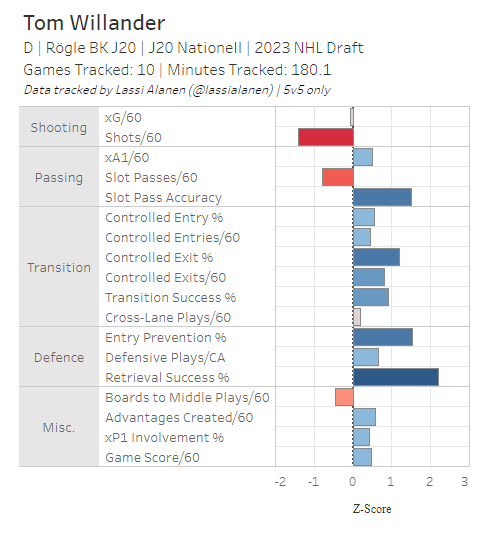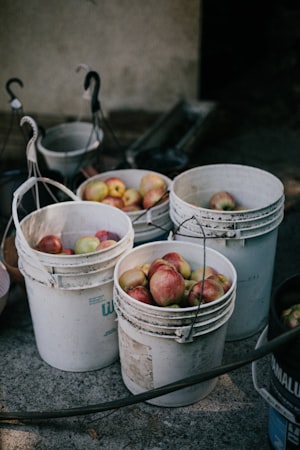I like two-way defensemen. To me, that means a few specific things beyond just the typical "good at offense and defense". It basically means having a very balanced set of tools and strengths. Being good defensively against transitions and in the defensive zone, being good at starting transitions by retrieving dump ins and getting up the ice with control, pushing the puck into the offensive zone, and facilitating offense in the O-zone by keeping it in, and making smart plays with the puck when it comes to the point.
No where in my definition of "two way defenseman" do I consider points. Consider me someone that doesn't really care about raw point production. Points for defensemen comes from powerplay time, having a good point shot, and playing a bit of a rover style in the offensive zone. Which is also good to have, but not what I consider to be the more important skill for a defenseman to have. A good two way defensemen will be doing enough things that they will get some points, but they will not necessarily be Roman Josi or Quinn Hughes. Not unless their name is Victor Hedman.
So Tom Willander is not Victor Hedman, I can say that with confidence. What he is is a Swedish defenseman who is definitely a strong two-way defenseman who seems to fit all that criteria I mentioned above. And if he does, that's the making of a very good NHL prospect.
So let's talk about him.
THE BASICS: STATS AND CONTEXT
- Position: Right-shot defenseman
- League(s): J20 National
- Height: 6'1"
- Weight: 179 lbs
- Birthdate: February 9th, 2005
Here are his draft rankings, as of writing this:
- Bob McKenzie: 46th
- Scott Wheeler: 27th
- Elite Prospects: 23rd
- Dobber Prospects: 39th
- Smaht Scouting: 54th
- Future Considerations: 61st

Tom Willander is a 6'1" right shot defenseman from Sweden. He started the year in the U18 junior league as a warmup to the Hlinka Gretzky tournament, where he had 2 points in 5 games while playing all over the lineup. Sometimes he was on the top pair on the right side, sometimes he was on the second pair on the left side. He was not the primary PP guy, but he was used more at even strength and on the PK.
Willander then returned to the U20 junior level, where he played for the rest of the season. He had 4 goals and 21 assists in 39 games. The reason for his lower amount of games played was a heavy international schedule. Between the Hlinka, the World U18s, and other tournaments Willander played in 39 total games for Sweden, where he had 8 goals and 18 assists. When the playoffs game, Willander played in both the U18 and U20 playoff runs for Rögle, where he had 8 and 4 points in 6 games each.
In short, Willander had a decent amount of offensive production. More importantly was the role he was used, especially towards the end of the year. He was routinely the top pairing guy used in all situations, both in Sweden's junior leagues and for Team Sweden. At the World U18 tournament, he had his best showing. He had 3 goals and 8 points in 7 games, and was playing 20+ minutes a game. In the gold medal game against the high octane Team USA, Willander played 30:36, the most on either team, in a close 3-2 overtime loss. Though his teammate Sandin Pelikka won the Top Defenseman award for the tournament, I'd argue that Willander was the more impactful in all situations.
Next year will be interesting. Willander was reportedly committed to the NCAA next year at Boston University who are developing a pretty strong team, especially on defense. BU already have Lane Hutson as a top defense prospect, and a Hutson-Willander pairing could be a ton of fun to watch. But that doesn't seem set in stone yet. Those reports from earlier this year have never been confirmed, and kinda died off later in the year.
While I don't know for sure if it is happening or not, this is the likely reason why Willander never got into any SHL games. Other top defense prospects in Sweden like Axel Sandin Pelikka and Theo Lindstein were given real shots in the SHL while Willander, as good as either of them, did not. Because if he did play in the pro league, that would eliminate his NCAA eligibility. It may be confusing as he is shown as having played two games for the SHL, but he didn't play any minutes for them.
All that context out of the way, let's talk about Willander's strengths and weaknesses.
THE GOOD: DEFENSIVE TOOLS AND OFFENSIVE FACILITATION
Willander's tools, both offensively and defensively, stem from two primary physical elements: his size and his skating. He is not necessarily a towering defender, but at 6'1" he has a good amount of reach to use to his benefit, without being too long in a way that makes handling pucks more difficult. This is an area where there is a good amount of projection to consider, because he's still pretty willowy. Adding more muscle will help his defensive game a lot, as well as making other physical skills (skating, shooting) more explosive.
Willander's skating is his bread and butter, however. He is arguably the best overall skater as a defense prospect in this year's draft. He may not be the fastest, but he has what scouts call "four way mobility" – this just means that he is very mobile forwards, backwards and side to side. It helps him both offensively and defensively, and is already at a very high level with room to improve.
A few Tom Willander (2023) clips from the previous viewings.
— Lassi Alanen (@lassialanen) February 22, 2023
Still remains one of my favorite prospects in this class. Easily an above-average skating projection, strong defensively both against the rush and in-zone, relatively mistake-free on breakouts. #2023NHLDraft pic.twitter.com/tMZcwqPTqf
Defensively, Willander's skating and his reach are definitely one of the big reasons why he is already so effective. He uses them to great effect shutting down the rush coming his way, getting quickly and aggressively in front of a puck carrier and forcing them to get rid of the puck (pass, dump in) or creating a turnover. Both allow him to cover a lot of ground very quickly, so he can disrupt what the offense in front of him attempts to do against him.
In the defensive zone, Willander uses his skating to stick with his man, and with his reach he covers a lot of ground. Once he closes on his man he engages, and wins a good amount puck battles around the net and along the boards. He'll be even more effective when he adds more muscle, but against his peers at the World U18s he was a monster, even against the high powered US team. Once he gets the puck in his end, he's great at making the first pass to get it out safely and with control, so his team can go on the attack.
Offensively, Willander profiles best as a puck mover – and I'm going to use that word again, he's a very good facilitator. You can see it in his tracking data, he uses his passing to exit the defensive zone, get it through the neutral zone, and set up scoring chances when in the offensive zone. He doesn't shoot that often, but he started to more with Team Sweden at the U18s and showed a pretty hard and accurate wrist shot. But he will default to passing most often, using his skating and mobility to create passing lanes and keep possessions alive at the blueline.
13 goals from Tom Willander in his draft year.
— 𝗖𝗵𝗿𝗶𝘀 Faber 🔥🎙 (@ChrisFaber39) May 17, 2023
Good movement to use screens on his wrist shot and a couple of great jumps to get back door finishes.
This isn’t even the strength of his game but there’s some offence there.#2023NHLDraft pic.twitter.com/wxqw6vQqKc
THE FLAWS: MASTER OF NONE?
I've said this in some of the other draft profiles already, but Willander has a bit of that "jack of all trades but master of none" things going for him. He does have a few areas of high end skill, as of now it's mostly his defense and ability to move the puck. But his defense is not the best in this draft, that likely goes to one of Simashev or Reinbacher. His puck movement is not the best, that would likely go to Sandin Pelikka or Gulyayev. His offense in terms of point production, driven from elite puck skills and offensive instincts, is also not the best. There are probably a few that are ahead of Willander for that as of now.
That's not necessarily a bad thing, but it does make you wonder if Willander projects all that highly. He could be a safer guy that winds up as a third, maybe second, pairing defenseman that plays good minutes at 5v5 and kills penalties, but you're never really going to be wowed by what he does on the ice. But if you want a swing for the fences, this guy could maybe be a top pairing guy – well there are probably better options who have better odds of achieving that, even if they also have better odds of not making the NHL because of other limitations.
That is always what I worry about with these kinds of players, because having a great skill – especially some of the most valuable ones, like scoring goals – is one of the best ways for someone to have an NHL career. Being just good or very good at a lot of them at once is not that easy or "safe", not unless they're all at a good enough level that they can make it work. And if they do make it work, it must just be as a competent NHLer that has a small, if any impact.
OVERALL ASSESSMENT
Willander will at the very least get a very solid all-around defenseman, who may not seem the sexiest but just... plays the damn game very well. He is young enough and has enough tools already that makes me think there is an NHL defenseman there. Especially with his defense and overall in-game intelligence, plus his physical tools like his size, reach and skating.
To me, Willander has a very similar set of tools and skills as Dmitri Simashev, who I profiled earlier this week. Both are very strong skaters, among the very best for defensemen in this year's draft. Willander is the better skater now, I'd say, but Simashev isn't far behind and I think may wind up just as effective with his movement in the long run. Both have very strong and already polished defensive skills, and both have hints of offensive potential. I would say that Simashev projects better defensively, and also has a few more inches in height and reach. but Willander has shown better overall offensive skills and execution. That, in theory, makes Willander the better balanced defenseman of the two.
Willander's rankings as of writing this are mostly as a 2nd round guy, but I expect that to change after his great U18 tournament. I've already seen some traditional scouting outlets like Corey Pronman and Craig Button give him a huge boost on their lists, well into the first round. Some even have him as a top 15 guy. When Bob McKenzie's final ranking comes out, I expect him to be around a late first/early second round guy, with a chance that one team takes him a bit earlier than that. Either way, I expect Willander to be in Toronto's range... even if he gets taken a bit before, he's in that tier. I try not to let one international tournament get me overhyped for a guy, but he has definitely gotten stronger through this season and deserves the bump. I think he is worth a first round pick, just probably not until the 20s. So if Toronto gets him? I'd be very happy.
Thanks for reading!
I put a lot of work into my prospect articles here, both for the draft and Toronto's prospects. I do it as a fun hobby for me, and I'd probably do it in some capacity even if PPP completely ceased to exist. But if you like reading my work, some support would go a long way! I pay for a few streaming services (CHL, some NCAA, some USHL, the occasional TSN options for international tournaments that are broadcast) to be able to reliably watch these prospects in good quality streams. I also pay for some prospect-specific resources, such as tracking data and scouting reports from outlets like Elite Prospects, Future Considerations, McKeen's Hockey, and The Athletic.
Being able to get paid for this helps me dedicate more time and resources to it, rather than to second/third jobs. And whatever money I make here, a lot of I reinvest back into my prospect work through in those streaming and scouting services. Like I said, I'd be doing whatever I can afford for this anyway, so any financial help I get through this is greatly appreciated!







Comment Markdown
Inline Styles
Bold: **Text**
Italics: *Text*
Both: ***Text***
Strikethrough: ~~Text~~
Code: `Text` used as sarcasm font at PPP
Spoiler: !!Text!!